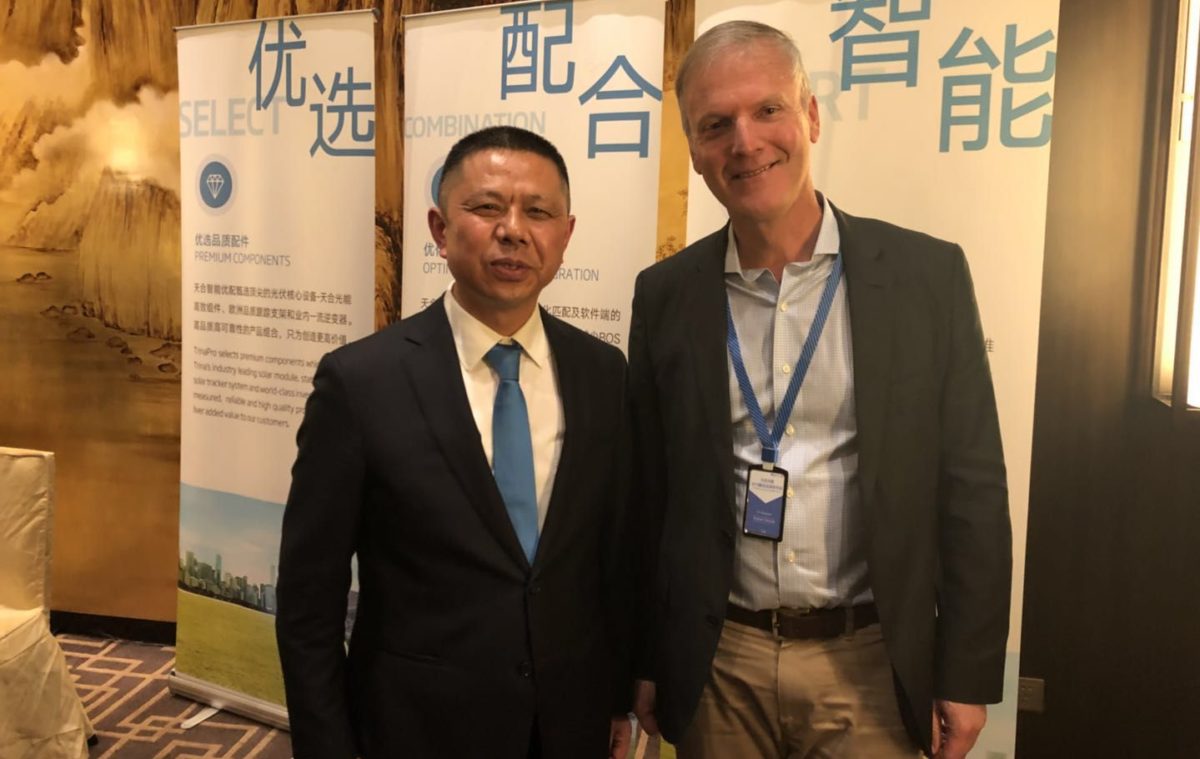The TrinaPro solution consists of premium components, including Trina Solar’s high efficiency panels, inverters from partners Huawei and Sungrow, and premium trackers from Spanish manufacturer, Nclave. One hallmark of TrinaPro is the use of bifacial double glass modules to further boost system output.
But this is not only a bifacial story, even though bifacial glass-glass modules are poised to have a major impact on the global PV market this year.
Another essential element of TrinaPro is its optimized system integration, which reduces balance of system (BOS) costs and obviates the need for other parts of the PV supply chain to address the optimal matching of components. In selecting Huawei, Nclave and Sungrow as strategic partners for this new business, Trina is also including best-of-breed suppliers in its solution.
Trina Solar refers to TrinaPro as a “smart PV solution” and this product is clearly an attempt to incorporate the latest IT technologies, which are having an increasing impact on PV systems and are helping to drive down solar LCOE.
Specifically, Trina has incorporated edge computing algorithms in TrinaPro, as well as harnessing cloud technology to optimize operations and maintenance. This is referred to as “smart O & M interconnection” with the “interconnection” consisting of a coupling of the edge computing algorithms with the cloud-based smart O & M system.
Although the technology giant, Apple was not mentioned at yesterday’s launch ceremony, the perfect matching of hardware and software, as well as the incorporation of cloud-based services, is a mantra the U.S. tech giant has pursued with great success, not least because of its visionary and quality-obsessed founder, Steve Jobs.
Jifan Gao is a pioneer of the global PV industry and, just like Jobs steered Apple clear of the commoditization of personal computers and mobile phones, Gao is keen to move Trina Solar away from being predominantly a supplier of commoditized panels, even if the company has broken conversion efficiency records 18 times in the past 20 years, as Gao remarked in his keynote address yesterday.
After shipping over 32 GW to over 100 countries around the world over the past 20 years, Gao has watched the cost of PV panels decline to a fraction of the costs when he started his venture in Changzhou in Jiangsu province in eastern China. This has catapulted solar PV to a position where it has now achieved grid parity in many markets.
However, the flip side of the coin is that this tremendous price decline has also impacted margins, making cell and module production a fairly low margin, high volume business. So to boost profitability and with it, to further reduce PV LCOE, embarking on the production of integrated PV solutions seems an attractive next step for Trina.
In Europe, IBC Solar AG has been one of Trina’s key partners and at yesterday’s launch ceremony, IBC’s shareholder, Julius Möhrstedt remarked that “Trina is always one step ahead.” And Trina’s bold move to introduce TrinaPro to the global market is just such a first-mover maneuver.
Of course, for a distributor like IBC, integrating best-of-breed components is one of its value-added services and it remains to be seen how distributors will react to an offering like TrinaPro, which already includes this integration in a one-stop solution.
TrinaPro has been developed for utility-scale and commercial and industrial (C & I) applications and the initial set of geographic markets targeted include China, the U.S., Latin America and the Middle East.
TrinaPro comes in various flavors, including a floating PV solution using centralized inverters from Sungrow. Floating PV is especially attractive in China’s home market, where lakes and fishing ponds dot provinces like Trina’s home province Jiangsu.
In an interview with pv magazine, Trina’s vice president of Global Sales and Marketing, Rongfang Yin, also points to markets like Japan, where very expensive land prices make floating PV projects attractive.
Yin expects TrinaPro to account for 15 to 18% of Trina’s global revenues this year, which would be an impressive figure for the launch year of this solution.
The manufacturer has not yet revealed pricing details and it will be interesting to compare the final pricing of TrinaPro in its various configurations with the pricing of systems that do not come out of the box, and where system components are procured individually.
That the conventional procurement process involves an additional layer of complexity and cost seems fairly straightforward, so we can expect integrated solutions like TrinaPro to usher in a new era of even lower priced PV systems, at least in the market segments where such out-of-the-box solutions make sense.
And if this allows module manufacturers to boost their margins, this development should be a welcome one for the global PV industry as a whole.
Author: Eckhart K. Gouras
This content is protected by copyright and may not be reused. If you want to cooperate with us and would like to reuse some of our content, please contact: editors@pv-magazine.com.



1 comment
By submitting this form you agree to pv magazine using your data for the purposes of publishing your comment.
Your personal data will only be disclosed or otherwise transmitted to third parties for the purposes of spam filtering or if this is necessary for technical maintenance of the website. Any other transfer to third parties will not take place unless this is justified on the basis of applicable data protection regulations or if pv magazine is legally obliged to do so.
You may revoke this consent at any time with effect for the future, in which case your personal data will be deleted immediately. Otherwise, your data will be deleted if pv magazine has processed your request or the purpose of data storage is fulfilled.
Further information on data privacy can be found in our Data Protection Policy.